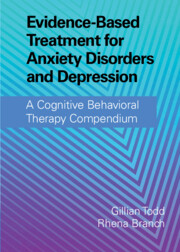 Evidence-Based Treatment for Anxiety Disorders and Depression
Evidence-Based Treatment for Anxiety Disorders and Depression Book contents
- Evidence-Based Treatment for Anxiety Disorders and Depression
- Evidence-Based Treatment for Anxiety Disorders and Depression
- Copyright page
- Contents
- Figures
- Tables
- Contributors
- 1 Introduction
- 2 The History and Philosophical Underpinnings of CBT:
- Part One Cognitive Behavioral Therapy for Anxiety Disorders
- 3 CBT for Specific Phobias
- 4 CBT for Panic Disorder
- 5 The Cognitive Behavioral Treatment of Agoraphobia
- 6 Cognitive Behavioral Therapy for Social Anxiety Disorder
- 7 CBT for Social Anxiety Disorder
- 8 CBT for Somatic Symptom Disorder and Illness Anxiety Disorder
- 9 Cognitive Behavioral Therapy for Generalized Anxiety Disorder:
- Part Two Cognitive Behavioral Therapy for Posttraumatic Stress Disorder
- Part Three Cognitive Behavioral Therapy for Obsessive-Compulsive Disorder and Associated Disorders
- Part Four Cognitive Behavioral Therapy for Depression
- Part Five Complexity and Comorbidity in Anxiety Disorders and Depression:
- Part Six Specialist Applications of Cognitive Behavioral Therapy for Anxiety Disorders and Depression
- Part Seven Future Developments
- Appendices
- Index
- References
8 - CBT for Somatic Symptom Disorder and Illness Anxiety Disorder
from Part One - Cognitive Behavioral Therapy for Anxiety Disorders
Published online by Cambridge University Press: 06 January 2022
- Evidence-Based Treatment for Anxiety Disorders and Depression
- Evidence-Based Treatment for Anxiety Disorders and Depression
- Copyright page
- Contents
- Figures
- Tables
- Contributors
- 1 Introduction
- 2 The History and Philosophical Underpinnings of CBT:
- Part One Cognitive Behavioral Therapy for Anxiety Disorders
- 3 CBT for Specific Phobias
- 4 CBT for Panic Disorder
- 5 The Cognitive Behavioral Treatment of Agoraphobia
- 6 Cognitive Behavioral Therapy for Social Anxiety Disorder
- 7 CBT for Social Anxiety Disorder
- 8 CBT for Somatic Symptom Disorder and Illness Anxiety Disorder
- 9 Cognitive Behavioral Therapy for Generalized Anxiety Disorder:
- Part Two Cognitive Behavioral Therapy for Posttraumatic Stress Disorder
- Part Three Cognitive Behavioral Therapy for Obsessive-Compulsive Disorder and Associated Disorders
- Part Four Cognitive Behavioral Therapy for Depression
- Part Five Complexity and Comorbidity in Anxiety Disorders and Depression:
- Part Six Specialist Applications of Cognitive Behavioral Therapy for Anxiety Disorders and Depression
- Part Seven Future Developments
- Appendices
- Index
- References
Summary
Somatic symptom disorder (SSD) entails a preoccupation with one or more physical symptoms that are attributed to a nonpsychiatric disease. Research on treatment for SSD supports the use of cognitive behavioral therapy (CBT) for reducing symptomatology and improving physical functioning and quality of life. This chapter summarizes the research base for CBT for SSD and provides a clinical guide to formulating, assessing, and implementing CBT for clients with SSD. Assessment requires ruling out organic medical conditions and assessing triggers of SSD, beliefs about body sensations, and associated safety behaviors. The use of a functional assessment and self-monitoring aids in developing an idiosyncratic case conceptualization. Treatment includes psychoeducation, cognitive restructuring to challenge beliefs about bodily sensations, a mix of interoceptive, in vivo, and imaginal exposure, and the elimination of all safety behaviors. The chapter concludes with a summary of recent advances in treatment of SSD, including mindfulness-based approaches.
Keywords
- Type
- Chapter
- Information
- Evidence-Based Treatment for Anxiety Disorders and DepressionA Cognitive Behavioral Therapy Compendium, pp. 136 - 151Publisher: Cambridge University PressPrint publication year: 2022


